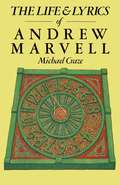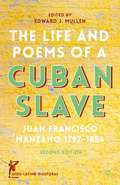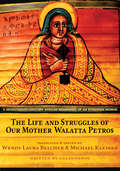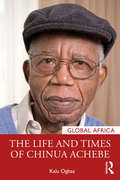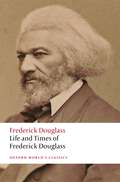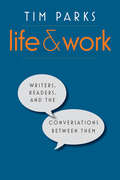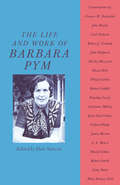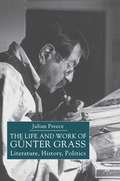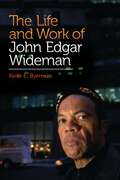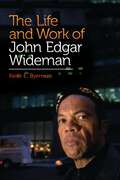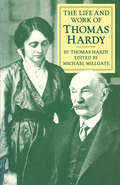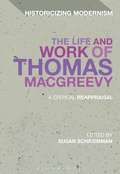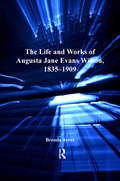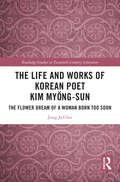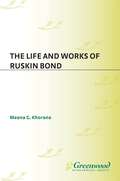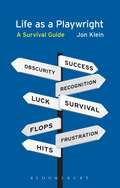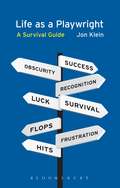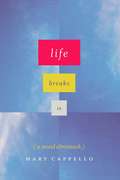- Table View
- List View
The Life and Poems of a Cuban Slave: Juan Francisco Manzano 1797–1854 (Afro-Latin@ Diasporas)
by J. ManzanoThis is a revised second edition of Edward Mullen's landmark scholarly presentation of Juan Francisco Manazo's autobiography and poetry. Taking into account the extensive scholarship that has accrued in the intervening decades, this is an accessible, essential resource for scholars and students of Caribbean literatures.
The Life and Poems of Anne Hunter: Haydn’s Tuneful Voice (Liverpool English Texts and Studies #56)
by Caroline GrigsonAnne Home Hunter (1741-1821) was one of the most successful song writers of the second half of the eighteenth century, most famously as the poet who wrote the lyrics of many of Haydn’s songs. However her work, which included many more serious, lyrical and romantic poems has been largely forgotten. This book contains over 200 poems, some published in her life-time under her married name ‘Mrs John Hunter’, some attributed only to ‘a Lady’, and most importantly many transcribed from her manuscripts, housed in various archives and in a private collection, which are now collected for the first time. Hitherto Anne Hunter has been known almost entirely through her ‘Poems’ published in 1802, in her Introduction Isobel Armstrong argues that she saw this book as a definitive representation of her poetry. Besides her consummately skilful lyrics and songs it contains serious political odes and reflective poems. The unpublished material amplifies and extends the work of 1802. The introduction is followed by a long biographical essay by Caroline Grigson. The daughter of Robert Home, an impoverished Scottish Army surgeon, Anne Hunter spent her adult life in London where she married the famous anatomist John Hunter, with whom she lived in great style, latterly as a bluestocking hostess, until his death in 1793. The book includes many new details of her long life, her friendship with Angelica Kaufman (who painted her portrait - see cover) and the bluestocking, Elizabeth Carter. The account of Anne’s life as a widow describes her relationships with her family, her niece the playwright Joanna Baillie, and her friends, especially those of the famous Minto family, as well as the Scottish impresario George Thomson. Of especial interest is the discovery of a previously unrecorded visit that Haydn made to her during his second London visit when she was living in Blackheath. Expertly researched which Grigson’s book sets Anne Hunter’s oeuvre in the political and social context of the time and will be required reading to scholars of literature and music alike.
The Life and Struggles of Our Mother Walatta Petros: A Seventeenth-Century African Biography of an Ethiopian Woman
by Galawdewos Wendy Laura Belcher Michael KleinerThis is the first English translation of the earliest-known book-length biography of an African woman, and one of the few lives of an African woman written by Africans before the nineteenth century. As such, it provides an exceedingly rare and valuable picture of the experiences and thoughts of Africans, especially women, before the modern era. It is also an extraordinary account of a remarkable life—full of vivid dialogue, heartbreak, and triumph.The Life and Struggles of Our Mother Walatta Petros (1672) tells the story of an Ethiopian saint who led a successful nonviolent movement to preserve African Christian beliefs in the face of European protocolonialism. When the Jesuits tried to convert the Ethiopians from their ancient form of Christianity, Walatta Petros (1592–1642), a noblewoman and the wife of one of the emperor's counselors, risked her life by leaving her husband, who supported the conversion effort, and leading the struggle against the Jesuits. After her death, her disciples wrote this book, praising her as a friend of women, a devoted reader, a skilled preacher, and a radical leader. One of the earliest stories of African resistance to European influence, this biography also provides a picture of domestic life, including Walatta Petros’s life-long relationship with a female companion.Richly illustrated with dozens of color illustrations from early manuscripts, this groundbreaking volume provides an authoritative and highly readable translation along with an extensive introduction. Other features include a chronology of Walatta Petros’s life, maps, a comprehensive glossary, and detailed notes on textual variants.
The Life and Times of Chinua Achebe (Global Africa)
by Kalu OgbaaThe Life and Times of Chinua Achebe introduces readers to the life, literary works, and times of arguably the most widely-read African novelist of recent times, an icon, both in continental Africa and abroad. The book weaves together the story of Chinua Achebe, a young Igboman whose novel Things Fall Apart opened the eyes of the world to a more realistic image of Africa that was warped by generations of European travelers, colonists, and writers. Whilst continuing to write further influential novels and essays, Achebe also taught other African writers to use their skills to help their national leaders to fight for their freedoms in the post-colonial era, as internal warfare compounded the damage caused by European powers during the colonial era. In this book Kalu Ogbaa, an esteemed expert on Achebe and his works, draws on extensive research and personal interviews with the great man and his colleagues and friends, to tell the story of Achebe and his work. This intimate and powerful new biography will be essential reading for students and scholars of Chinua Achebe, and to anyone with an interest in the literature and post-colonial politics of Africa.
The Life and Times of Chinua Achebe (Global Africa)
by Kalu OgbaaThe Life and Times of Chinua Achebe introduces readers to the life, literary works, and times of arguably the most widely-read African novelist of recent times, an icon, both in continental Africa and abroad. The book weaves together the story of Chinua Achebe, a young Igboman whose novel Things Fall Apart opened the eyes of the world to a more realistic image of Africa that was warped by generations of European travelers, colonists, and writers. Whilst continuing to write further influential novels and essays, Achebe also taught other African writers to use their skills to help their national leaders to fight for their freedoms in the post-colonial era, as internal warfare compounded the damage caused by European powers during the colonial era. In this book Kalu Ogbaa, an esteemed expert on Achebe and his works, draws on extensive research and personal interviews with the great man and his colleagues and friends, to tell the story of Achebe and his work. This intimate and powerful new biography will be essential reading for students and scholars of Chinua Achebe, and to anyone with an interest in the literature and post-colonial politics of Africa.
Life and Times of Frederick Douglass: Written by Himself (Oxford World's Classics)
by Frederick Douglass'It will be seen in these pages that I have lived several lives in one: first, the life of slavery; secondly, the life of a fugitive from slavery; thirdly, the life of comparative freedom; fourthly, the life of conflict and battle; and, fifthly, the life of victory, if not complete, at least assured.' First published in 1892, Life and Times of Frederick Douglass Written By Himself is the final autobiography written by Frederick Douglass (1818-1895), a man who was born into slavery in Talbot County, Maryland. Securing his self-liberation at twenty years of age in 1838, he went on to become the most renowned antislavery activist, social justice campaigner, author, orator, philosopher, essayist, historian, intellectual, statesman, and liberator in U.S. history. A powerful literary work, Douglass' final autobiography shares the stories of his 'several lives in one.' Beginning with his war against 'the hell-black system of human bondage,' Douglass bears witness to his personal experiences of mind-body-and soul-destroying tragedies. Living a new life as a 'fugitive from slavery,' he tells his audiences of his decades-long labours as a world-leading freedom-fighter. Ever vigilant in his protest against the discriminatory persecutions endured by millions of 'my people,' he testifies to the terrible reality that his 'life of comparative freedom' necessitated a lifelong fight against the inhumane injustices of 'American prejudice against colour.' Living a death-defying 'life of conflict and battle' during the Civil War, Douglass celebrates the 'life of victory' promised by post-war civil rights legislation only to condemn the failures of the U.S. nation either to exterminate slavery or secure equal rights for all. All too painfully aware that the 'conflict between the spirit of liberty and the spirit of slavery' was far from over and would become the unending struggle for 'aftercoming generations' in the ongoing war against white supremacy, Douglass remained a fearless fighter against the 'infernal and barbarous spirit of slavery' 'wherever I find it' to the day that he died. This new edition examines Douglass' memorialization of his own and his mother Harriet Bailey's first-hand experiences of enslavement and of their 'mental' liberation through a 'love of letters'; his representation of Civil War Black combat heroism; his conviction that 'education means emancipation'; and finally, his 'unending battle' with white publishers for the freedom to 'tell my story.' This volume reproduces Frederick Douglass' emotionally powerful and politically hard-hitting anti-lynching speech, Lessons of the Hour, published in 1894. ABOUT THE SERIES: For over 100 years Oxford World's Classics has made available the widest range of literature from around the globe. Each affordable volume reflects Oxford's commitment to scholarship, providing the most accurate text plus a wealth of other valuable features, including expert introductions by leading authorities, helpful notes to clarify the text, up-to-date bibliographies for further study, and much more.
Life and Times of Frederick Douglass: Written by Himself (Oxford World's Classics)
by Frederick Douglass'It will be seen in these pages that I have lived several lives in one: first, the life of slavery; secondly, the life of a fugitive from slavery; thirdly, the life of comparative freedom; fourthly, the life of conflict and battle; and, fifthly, the life of victory, if not complete, at least assured.' First published in 1892, Life and Times of Frederick Douglass Written By Himself is the final autobiography written by Frederick Douglass (1818-1895), a man who was born into slavery in Talbot County, Maryland. Securing his self-liberation at twenty years of age in 1838, he went on to become the most renowned antislavery activist, social justice campaigner, author, orator, philosopher, essayist, historian, intellectual, statesman, and liberator in U.S. history. A powerful literary work, Douglass' final autobiography shares the stories of his 'several lives in one.' Beginning with his war against 'the hell-black system of human bondage,' Douglass bears witness to his personal experiences of mind-body-and soul-destroying tragedies. Living a new life as a 'fugitive from slavery,' he tells his audiences of his decades-long labours as a world-leading freedom-fighter. Ever vigilant in his protest against the discriminatory persecutions endured by millions of 'my people,' he testifies to the terrible reality that his 'life of comparative freedom' necessitated a lifelong fight against the inhumane injustices of 'American prejudice against colour.' Living a death-defying 'life of conflict and battle' during the Civil War, Douglass celebrates the 'life of victory' promised by post-war civil rights legislation only to condemn the failures of the U.S. nation either to exterminate slavery or secure equal rights for all. All too painfully aware that the 'conflict between the spirit of liberty and the spirit of slavery' was far from over and would become the unending struggle for 'aftercoming generations' in the ongoing war against white supremacy, Douglass remained a fearless fighter against the 'infernal and barbarous spirit of slavery' 'wherever I find it' to the day that he died. This new edition examines Douglass' memorialization of his own and his mother Harriet Bailey's first-hand experiences of enslavement and of their 'mental' liberation through a 'love of letters'; his representation of Civil War Black combat heroism; his conviction that 'education means emancipation'; and finally, his 'unending battle' with white publishers for the freedom to 'tell my story.' This volume reproduces Frederick Douglass' emotionally powerful and politically hard-hitting anti-lynching speech, Lessons of the Hour, published in 1894. ABOUT THE SERIES: For over 100 years Oxford World's Classics has made available the widest range of literature from around the globe. Each affordable volume reflects Oxford's commitment to scholarship, providing the most accurate text plus a wealth of other valuable features, including expert introductions by leading authorities, helpful notes to clarify the text, up-to-date bibliographies for further study, and much more.
Life and Work: Writers, Readers, and the Conversations between Them
by Tim ParksAcclaimed novelist and critic Tim Parks has long been fascinated by the complicated relationship between an author’s life and work. Dissatisfied with the dominant modes of reading he encountered, he began exploring the underlying values and patterns that guide authors in both their writing and their lives. In a series of provocative, incisive, and unflinching essays written over the past decade and collected for the first time here, he reveals how style and content in a novel reflect a whole pattern of communication and positioning in the author’s ordinary and daily behavior. We see how life and work are deeply enmeshed in the work of writers as diverse as Charles Dickens, Feodor Dostoevsky, James Joyce, Anton Chekhov, Philip Roth, Julian Barnes, Peter Stamm, and Geoff Dyer, among others. Parks further shows us how readers’ reactions to these writers and their works are inevitably connected to these communicative patterns, establishing a relationship that goes far beyond aesthetic appreciation. This original and daring collection takes us into the psychology of some of our greatest writers and challenges us to see with more clarity how our lives become entangled with theirs through our reading of their novels.
The Life and Work of Gunter Grass: Literature, History, Politics
by J. PreeceThis book traces the career of the most widely read and influential German novelist in the second half of the Twentieth-century. It shows in particular how his experiences as a teenage Nazi shaped his thinking, both in his novels and his role as critic and campaigner, from The Tin Drum (1959), his most famous novel, to My Century (1999), from his public protest against the building of the Berlin Wall (1961) to his diatribes against Helmut Kohl in the late 1990s. This new paperback edition includes new material on his last two books, My Century and Crabwalk including a revised Bibliography and Chronology.
The Life and Work of John Edgar Wideman
by Keith E. ByermanChallenging. Successful. Controversial. All terms used to accurately describe African American novelist and autobiographer John Edgar Wideman. This book examines his life and work—and the connections between them.The Life and Work of John Edgar Wideman is ideal for readers who might not be familiar with Wideman's work or those who may have been intimidated by descriptions of his writings. Through its coverage of Wideman's life from several generations back to the present and explanations of how Wideman makes use of life experiences, this book breaks down barriers for new readers and enables them to better relate and connect to his writing. Author Keith E. Byerman discusses Wideman's book-length works of fiction and nonfiction, as well as some of his shorter, journalistic pieces. The book emphasizes how Wideman integrates family and personal experience into what is typically labeled postmodern writing, and explains how he has evolved as a public intellectual who supplies shrewd commentary on subjects such as the prison system, terrorism, and the role of sports in American society.
The Life and Work of John Edgar Wideman
by Keith E. ByermanChallenging. Successful. Controversial. All terms used to accurately describe African American novelist and autobiographer John Edgar Wideman. This book examines his life and work—and the connections between them.The Life and Work of John Edgar Wideman is ideal for readers who might not be familiar with Wideman's work or those who may have been intimidated by descriptions of his writings. Through its coverage of Wideman's life from several generations back to the present and explanations of how Wideman makes use of life experiences, this book breaks down barriers for new readers and enables them to better relate and connect to his writing. Author Keith E. Byerman discusses Wideman's book-length works of fiction and nonfiction, as well as some of his shorter, journalistic pieces. The book emphasizes how Wideman integrates family and personal experience into what is typically labeled postmodern writing, and explains how he has evolved as a public intellectual who supplies shrewd commentary on subjects such as the prison system, terrorism, and the role of sports in American society.
The Life and Work of Thomas Hardy
by Thomas HardyOne of the literary world's great deceptions was perpetrated when Thomas Hardy wrote his Life in secret for publication after his death as an official biography. Since the true circumstances of its composition have been known The Early Life and Later Years of Thomas Hardy, published over the name of Florence Emily Hardy, has frequently been referred to as Hardy's autobiography. But this is not the whole truth: Florence altered much of what Hardy meant to appear in his 'biography'. Through careful examination of pre- publication texts, Michael Millgate has retrieved the text as it stood at the time of Hardy's final revision. For the first time The Life and Work of Thomas Hardy can be read as a true work of autobiography - an addition to the Hardy canon.
The Life and Work of Thomas MacGreevy: A Critical Reappraisal (Historicizing Modernism)
by Susan SchreibmanAs a poet and literary critic, Thomas MacGreevy is a central force in Irish modernism and a crucial facilitator in the lives of key modernist writers and artists. The extent of his legacy and contribution to modernism is revealed for the first time in The Life and Work of Thomas MacGreevy. Split into four sections, the volume explains how and where MacGreevy made his impact: in his poetry; his role as a literary and art critic; during his time in Dublin, London and Paris and through his relationships with James Joyce, Samuel Beckett, Wallace Stevens, Jack B Yeats and WB Yeats. With access to the Thomas MacGreevy Archive, contributors draw on letters, his early poetry, and contributions to art and literary journals, to better understand the first champion of Jack B. Yeats, and Beckett's chief correspondent and closest friend in the 1930s. This much-needed reappraisal of MacGreevy, the linchpin between the main modernist writers, fills missing gaps, not only in the story of Irish modernism, but in the wider history of the movement.
The Life and Work of Thomas MacGreevy: A Critical Reappraisal (Historicizing Modernism)
by Susan SchreibmanAsa poet and literary critic, Thomas MacGreevy is a central force in Irishmodernism and a crucial facilitator in the lives of key modernist writers andartists. The extent of his legacy and contribution to modernism is revealed forthe first time in The Life and Work of Thomas MacGreevy. Â Splitinto four sections, the volume explains how and where MacGreevy made hisimpact: in his poetry; his role as a literary and art critic; during his timein Dublin, London and Paris and through his relationships with James Joyce,Samuel Beckett, Wallace Stevens, Jack B Yeats and WB Yeats. With access to the Thomas MacGreevy Archive, contributorsdraw on letters, his early poetry, and contributions to art and literaryjournals, to better understand the first champion of Jack B. Yeats, andBeckett's chief correspondent and closest friend in the 1930s. This much-needed reappraisal of MacGreevy,the linchpin between the main modernist writers, fills missing gaps, not onlyin the story of Irish modernism, but in the wider history of the movement.
The Life and Works of Augusta Jane Evans Wilson, 1835-1909
by Brenda AyresOver the course of her 57-year career, Augusta Jane Evans Wilson published nine best-selling novels, but her significant contributions to American literature have until recently gone largely unrecognized. Brenda Ayres, in her long overdue critical biography of the novelist once referred to as the 'first Southern woman to enter the field of American letters,' credits the importance of Wilson's novels for their portrait of nineteenth-century America. As Ayres reminds us, the nineteenth-century American book market was dominated by women writers and women readers, a fact still to some extent obscured by the make-up of the literary canon. In placing Wilson's novels firmly within their historical context, Ayres commemorates Wilson as both a storyteller and maker of American history. Proceeding chronologically, Ayres devotes a chapter to each of Wilson's novels, showing how her views on Catholicism, the South, the Civil War, male authority, domesticity, Reconstruction, and race were both informed by and resistant to the turbulent times in which she lived. This comprehensive and meticulously researched biography contributes not only to our appreciation of Wilson's work, but also to her importance as a figure for understanding women's roles in history and their art, evolving gender roles, and the complicated status of women writers.
The Life and Works of Augusta Jane Evans Wilson, 1835-1909
by Brenda AyresOver the course of her 57-year career, Augusta Jane Evans Wilson published nine best-selling novels, but her significant contributions to American literature have until recently gone largely unrecognized. Brenda Ayres, in her long overdue critical biography of the novelist once referred to as the 'first Southern woman to enter the field of American letters,' credits the importance of Wilson's novels for their portrait of nineteenth-century America. As Ayres reminds us, the nineteenth-century American book market was dominated by women writers and women readers, a fact still to some extent obscured by the make-up of the literary canon. In placing Wilson's novels firmly within their historical context, Ayres commemorates Wilson as both a storyteller and maker of American history. Proceeding chronologically, Ayres devotes a chapter to each of Wilson's novels, showing how her views on Catholicism, the South, the Civil War, male authority, domesticity, Reconstruction, and race were both informed by and resistant to the turbulent times in which she lived. This comprehensive and meticulously researched biography contributes not only to our appreciation of Wilson's work, but also to her importance as a figure for understanding women's roles in history and their art, evolving gender roles, and the complicated status of women writers.
The Life and Works of Korean Poet Kim Myŏng-sun: The Flower Dream of a Woman Born Too Soon (Routledge Studies in Twentieth-Century Literature)
by Jung Ja ChoiThe Life and Works of Korean Poet Kim Myŏng-sun offers an introduction to Korea’s first modern woman writer to publish a collection of creative works, Kim Myŏng-sun (1896–ca. 1954). Despite attempts by male contemporaries to assassinate her character, Kim was an outspoken writer and an early feminist, confronting patriarchal Korean society in essays, plays, poems, and short stories. This volume is the first to offer a detailed analysis in English of Kim’s poetry. The poems examined in this volume can be considered early twentieth-century versions of #MeToo literature, mirroring the harrowing account of her sexual assault, and also subversive challenges to traditional institutions, dealing with themes such as romantic free love, same-sex love, single womanhood, and explicit female desire and passion. The Life and Works of Korean Poet Kim Myŏng-sun restores a long-neglected woman writer to her rightful place in the history of Korean literature, shedding light on the complexity of women’s lives in Korea and contributing to the growing interest in modern Korean women’s literature in the West.
The Life and Works of Korean Poet Kim Myŏng-sun: The Flower Dream of a Woman Born Too Soon (Routledge Studies in Twentieth-Century Literature)
by Jung Ja ChoiThe Life and Works of Korean Poet Kim Myŏng-sun offers an introduction to Korea’s first modern woman writer to publish a collection of creative works, Kim Myŏng-sun (1896–ca. 1954). Despite attempts by male contemporaries to assassinate her character, Kim was an outspoken writer and an early feminist, confronting patriarchal Korean society in essays, plays, poems, and short stories. This volume is the first to offer a detailed analysis in English of Kim’s poetry. The poems examined in this volume can be considered early twentieth-century versions of #MeToo literature, mirroring the harrowing account of her sexual assault, and also subversive challenges to traditional institutions, dealing with themes such as romantic free love, same-sex love, single womanhood, and explicit female desire and passion. The Life and Works of Korean Poet Kim Myŏng-sun restores a long-neglected woman writer to her rightful place in the history of Korean literature, shedding light on the complexity of women’s lives in Korea and contributing to the growing interest in modern Korean women’s literature in the West.
The Life and Works of Ruskin Bond (Contributions to the Study of World Literature)
by Meena KhoranaRuskin Bond is known internationally as one of India's most prolific writers in English for children, young adults, and adults. This literary biography analyzes the impact of personal, social, geographical, political, and literary influences on Bond's worldview, aesthetic principles, and writings. Connecting the development of Bond's writing career over the past 50 years to the evolution of the publishing industry in India, Khorana details the author's pioneering work in the field of children's and young adult literature, and his contribution to diasporic and postcolonial/post-independence literatures. She concludes that it is Bond's versatile, original, and elegant writing in a variety of genres that continue to endear him to readers around the world.According to the author, despite Bond's British background, he does not write about India from a Eurocentric perspective. Having lived the majority of his life in India, he knows the country as an insider, writing with an authenticity and emotional engagement about the land and the people of the Himalayas and small-town India. Khorana analyzes his novels and short stores, and highlights his juxtaposition of his protagonists' individual dramas against larger social, moral, and metaphysical issues. In addition, she reveals how the autobiographical and regional elements in Bond's work provide insight into universal themes such as the tension between past and present, city life versus rural values, the dignity of ordinary folk, preservation of the environment, and living in harmony with nature.
Life as a Playwright: A Survival Guide
by Jon KleinAddressing the questions central to any playwright's career and identity, Jon Klein offers you a glimpse into a career writing for the theatre. As well as an account of the day-to-day life of a writer, he also discusses what an aspiring playwright should expect as they navigate the industry and how to make yourself stand out from the crowd. Furthermore, the book looks at situations that the emerging playwright is likely to encounter, including: handling rehearsals, workshops, castings, re-writing, venues, reviews, successes and failure. The book concludes with seventeen interviews with other USA-based playwrights, representing a wide range of experience, from writers just starting to make a name for themselves to seasoned, award-winning veterans such as Sheila Callaghan, Steven Dietz, Keith Glover, Lauren Gunderson, John Pielmeier and Jen Silverman. Author Jon Klein has a wealth of experience with over 30 of his plays produced in the USA and over 100 productions, including include T Bone N Weasel, Dimly Perceived Threats to the System, Betty the Yeti, and his most recent play, Resolving Hedda. Klein draws upon the lessons he has learned from his associations with numerous established theatre folk, many from the start of their careers. These include figures such as Bob Falls, Gregory Hines, Jon Jory, Kenny Leon, Dan Sullivan, and August Wilson.clude figures such as Bob Falls, Gregory Hines, Jon Jory, Kenny Leon, Dan Sullivan, and August Wilson.
Life as a Playwright: A Survival Guide
by Jon KleinAddressing the questions central to any playwright's career and identity, Jon Klein offers you a glimpse into a career writing for the theatre. As well as an account of the day-to-day life of a writer, he also discusses what an aspiring playwright should expect as they navigate the industry and how to make yourself stand out from the crowd. Furthermore, the book looks at situations that the emerging playwright is likely to encounter, including: handling rehearsals, workshops, castings, re-writing, venues, reviews, successes and failure. The book concludes with seventeen interviews with other USA-based playwrights, representing a wide range of experience, from writers just starting to make a name for themselves to seasoned, award-winning veterans such as Sheila Callaghan, Steven Dietz, Keith Glover, Lauren Gunderson, John Pielmeier and Jen Silverman. Author Jon Klein has a wealth of experience with over 30 of his plays produced in the USA and over 100 productions, including include T Bone N Weasel, Dimly Perceived Threats to the System, Betty the Yeti, and his most recent play, Resolving Hedda. Klein draws upon the lessons he has learned from his associations with numerous established theatre folk, many from the start of their careers. These include figures such as Bob Falls, Gregory Hines, Jon Jory, Kenny Leon, Dan Sullivan, and August Wilson.clude figures such as Bob Falls, Gregory Hines, Jon Jory, Kenny Leon, Dan Sullivan, and August Wilson.
Life as Creative Constraint: Autobiography and the Oulipo (Contemporary French and Francophone Cultures #76)
by Anna KempLife as Creative Constraint is the first book to focus on the extraordinary life-writing of the French experimental writing group, the Oulipo. The Oulipo's enthusiasm for literary games and formal gymnastics has seen its work caricatured as 'lifeless' - impressively virtuoso but more interested in form than content and ultimately disengaged from the world. This book examines a broad corpus of work by Georges Perec, Marcel Bénabou, Jacques Roubaud and Anne F. Garréta to show that, despite the group's early devotion to the radical impersonality of mathematics, later generations of oulipians have brought the group's fascination with systems, games and constraints to bear on autobiography. Far from being 'lifeless', oulipian constraints and concepts provide the tools that allow writers to engage critically and creatively with lived experience, and mine the potential of the autobiographical genre. The games played by these writers are not simply pastimes or cunning writing techniques, but modes of survival, self-examination, self-invention, and relating to the world and to others. As the title of Georges Perec’s masterpiece suggests, they are a mode d’emploi for life.
Life Breaks In: A Mood Almanack
by Mary Cappello Rosamond PurcellSome books start at point A, take you by the hand, and carefully walk you to point B, and on and on. This is not one of those books. This book is about mood, and how it works in and with us as complicated, imperfectly self-knowing beings existing in a world that impinges and infringes on us, but also regularly suffuses us with beauty and joy and wonder. You don’t write that book as a linear progression—you write it as a living, breathing, richly associative, and, crucially, active, investigation. Or at least you do if you’re as smart and inventive as Mary Cappello. What is a mood? How do we think about and understand and describe moods and their endless shadings? What do they do to and for us, and how can we actively generate or alter them? These are all questions Cappello takes up as she explores mood in all its manifestations: we travel with her from the childhood tables of “arts and crafts” to mood rooms and reading rooms, forgotten natural history museums and 3-D View-Master fairytale tableaux; from the shifting palette of clouds and weather to the music that defines us and the voices that carry us. The result is a book as brilliantly unclassifiable as mood itself, blue and green and bright and beautiful, funny and sympathetic, as powerfully investigative as it is richly contemplative. “I’m one of those people who mistrusts a really good mood,” Cappello writes early on. If that made you nod in recognition, well, maybe you’re one of Mary Cappello’s people; you owe it to yourself to crack Life Breaks In and see for sure.
